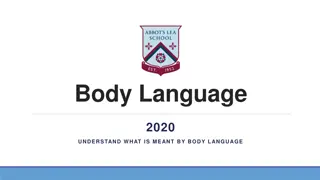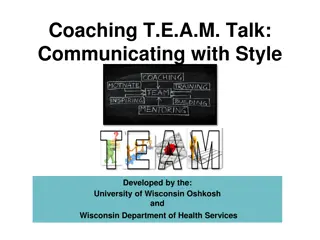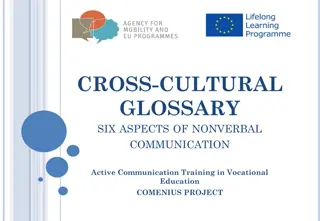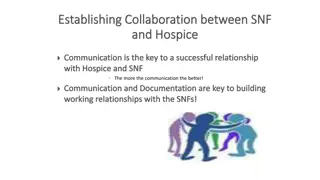Importance of Nonverbal Communication in Healthcare
Understanding and utilizing nonverbal communication plays a crucial role in effective healthcare delivery. This presentation explores the significance of soft skills, including nonverbal communication, in healthcare settings. It covers different types of nonverbal cues, activities to enhance understanding, and the impact of body language on communication effectiveness. Learn about the importance of communication skills for healthcare professionals and how they contribute to better patient care outcomes.
Download Presentation

Please find below an Image/Link to download the presentation.
The content on the website is provided AS IS for your information and personal use only. It may not be sold, licensed, or shared on other websites without obtaining consent from the author.If you encounter any issues during the download, it is possible that the publisher has removed the file from their server.
You are allowed to download the files provided on this website for personal or commercial use, subject to the condition that they are used lawfully. All files are the property of their respective owners.
The content on the website is provided AS IS for your information and personal use only. It may not be sold, licensed, or shared on other websites without obtaining consent from the author.
E N D
Presentation Transcript
WHAT TO EXPECT IN THIS PRESENTATION Overview of the importance of nonverbal communication Understanding nonverbal communication Types of nonverbal communication A variety of activities
IMPORTANCE OF SOFT SKILLS Communication is the skill that can possibly have the greatest impact on effective healthcare delivery. It really is the key to clinical governance and demands as much attention, respect and sustaining as other seemingly harder targets. However, often the mere mention of the importance of communication causes less than positive reactions in healthcare professionals. (Jelphs, 2006, senior fellow at the Health Services Management Centre at the University of Birmingham)
ACTIVITY: NONVERBAL QUESTIONNAIRE Giving someone a big hug. Using American Sign Language to send a message to someone. Writing a note to a colleague on a pad of paper during a boring meeting. Tapping your watch to signal your friend that it s nearly time for lunch.
BODY LANGUAGE: SOME SAY ITS JUST ABOUT 65% ...(BURGOON, 1994) Others have suggested the message impact % below when messages are related to feelings and attitudes: WORDS 7% What we do know for sure is that when words and body language don t align, we believe the body language and paralanguage. Body Language 55% Tone of Voice 38% Based on the work by Albert Mehrabian
TURNIP ACTIVITY Find a partner Partner One: Explain what a turnip is without using any words. Partner Two: Communicate to your partner how you feel about the taste of a turnip. Partner Two (or Three): Describe the Declaration of Independence, without using any words. ALL: Demonstrate frustration using body language and nonverbal communication!
NONVERBAL COMMUNICATION Appearance & Adornment Use of Space (Proxemics) Use of Time (Chronemics) Environment & Artifacts Nonverbal Communication Touch (Haptics) Eye Contact & Facial Expressions Body Language (Kinesics) Paralanguage
NONVERBAL COMMUNICATION REALITIES You can never not communicate! Nonverbal communication: Helps manage our identity Is ambiguous Is relational and better at conveying emotions Is contextual and cultural
I suppose it was something you said that caused me to tighten and pull away. And when you asked, What is it? I, of course, said, Nothing. Whenever I say Nothing, you may be very certain there is something. The something is an old, hard lump of Nothing. Louis Wyse
ACTIVITY: FINE First partner: Ask, How are you? Second partner: Say the word fine and use a negative tone to suggest not really fine. Second partner: Ask, How are you? First partner: Say the word fine and use a positive tone to suggest you are good. First partner: Ask, How are you? Second partner: Say the word fine and use an angry tone. Second partner: Ask, How are you? First partner: Say the word fine as if it s your best day ever!
TYPES OF NONVERBAL COMMUNICATION Body movement Body orientation: How much you face toward another person, including with your body, shoulders, feet, and head. Posture: Says a lot and can give clues to your position in status and emotion. Gestures: A league of their own. Illustrators--only make sense with the words like pointing while giving directions. Emblems--stand alone meaning-like head nod for yes. Adaptors--unconscious moves like shivering when cold (very important in patient assessment). Manipulators--self-touching like finger twiddling.
ITS AMBIGUOUS, RELATIONAL, AND CONTEXTUAL; AND, IT MAY NOT MEAN WHAT YOU THINK. Use caution when giving meaning to nonverbal behaviors.
TYPES OF NONVERBAL COMMUNICATION Face and eyes Too many ways to describe Hard to understand because they change rapidly They send multiple messages from interest to dominance and submission Stare down! Pupil dilation has meaning Larger with degree of interest in subject viewed
TYPES OF NONVERBAL COMMUNICATION Voice: also called paralanguage Tone Rate Pitch Volume Pauses Unintentional to collect thoughts Vocalized pauses such as um and like ya know Can reduce perceived credibility
ACTIVITY: PITCH AND INFLECTION WILL you clean up this mess with me tonight? Will YOU clean up this mess with me tonight? Will you clean up this MESS with me tonight? Will you clean up this mess with ME tonight? Will you clean up this mess with me TONIGHT?
TYPES OF NONVERBAL COMMUNICATION Touch (also called Haptics) Touch can communicate many messages Several factors make a given touch more or less intense: Which part of the body does the touching Which part of the body is touched How long the touch lasts The amount of pressure used The situation in which the touch occurred If done appropriately, touch usually influences a positive response.
TYPES OF NONVERBAL COMMUNICATION Appearance/Adornment Physical Attractiveness Men and women whom others perceive as attractive are rated as: Being more sensitive Kind Strong Sociable Interesting It also impacts hiring, promotion, and performance evaluations.
CASE STUDY: HOW MUCH IS THAT RING WORTH?
TYPES OF NONVERBAL COMMUNICATION Physical Space Proxemics The study of the way people and animals use space We each carry an invisible bubble of personal space wherever we go Territoriality We claim an area with continuous occupation or implied ownership of an area Environment We use space to express our practical and personal selves
MY PERSONAL BUBBLE ACTIVITY Public distance Distances beyond twelve feet Social distance Four feet to twelve feet Personal distance Ranges from eighteen inches to four feet At arms distance close but not intimately so Intimate distance Kissing to about eighteen inches out
REPORT OUT What did you notice about your own nonverbal communication and specifically body language during the distance experience? How did you feel? What did you notice about the other person s nonverbal behaviors?
STOP YOURE ON FIRE ACTIVITY Say it as if the person is reallyon fire. --use vocal urgency Say it as if the person is boring. --use vocal sarcasm Say it as if the person is doing something worthy of praise. --use vocal enthusiasm
LARGE GROUP REPORT OUT What did you notice about the volume and tone in the room? What did you notice about your partner s gestures and facial expressions? What did you notice about your own and your partner s body language? What other observations would you like to share?
THANK YOU! Questions? Comments?























